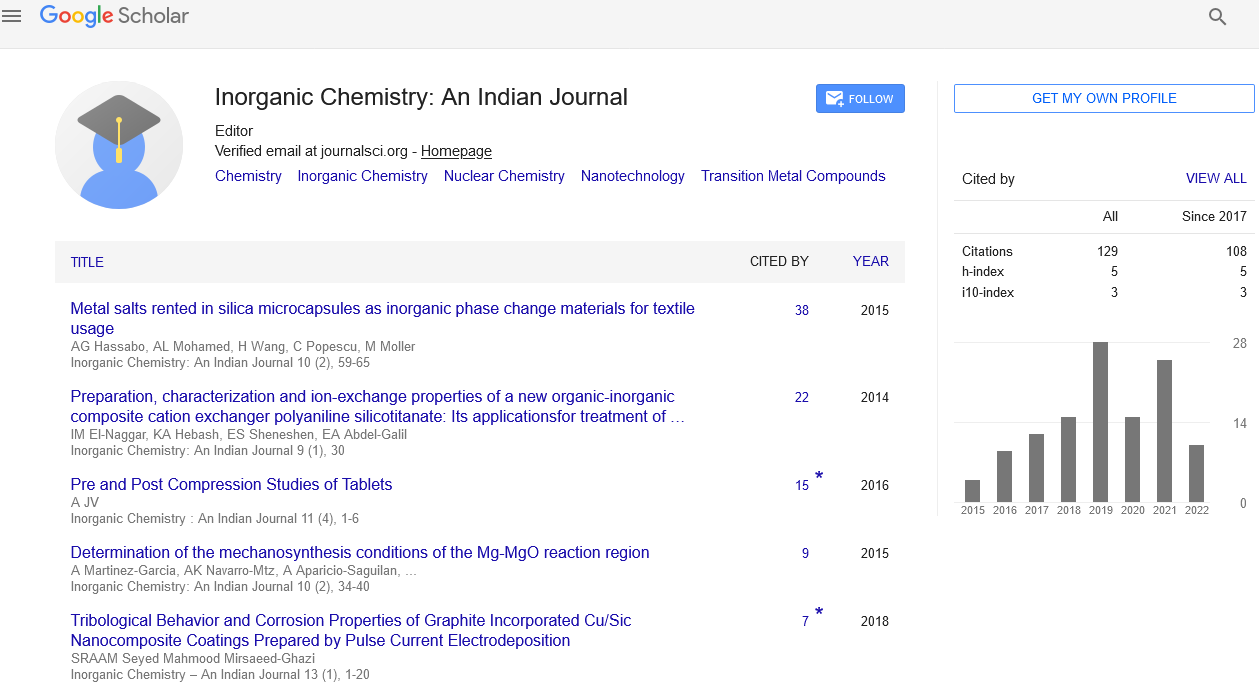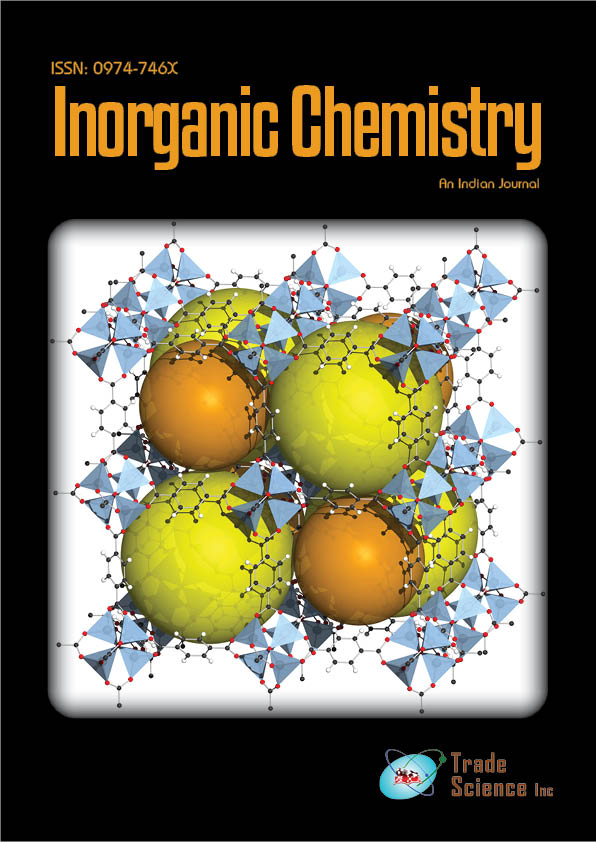Original Article
, Volume: 13( 1)Solubility in the Quaternary CaSO4ÃÂCaCO3ÃÂCaF2ÃÂH2O System at 50úC
- *Correspondence:
- Soliev L Tajik State Pedagogical University, Dushanbe, Tajikistan, Tel: +992 93 915 7000; E-Mail: soliev.lutfullo@yandex.com
Received Date: December 12, 2018 Accepted Date: May 26, 2018 Published Date: May 31, 2018
Citation: Soliev L, Mukhtorov P, Tursunbadalov SH, et al. Solubility In The Quaternary CaSO4-CaCO3-CaF2-H2O System At 50ºC. Inorg Chem Ind J. 2018;13(1):124.
Abstract
Background: The four-component system CaSO4Ë—CaCO3Ë—CaF2Ë—H2O is a subsystem of more complex six-component system Na, Ca SO4,CO3,HCO3,FË—H2O whose state of phase equilibria determines the conditions for utilization of liquid wastes of aluminum production. Aim: To investigate the solubility in the quaternary CaSO4Ë—CaCO3Ë—CaF2Ë—H2O system and construction of its solubility diagram at 50ºC. Methods: In the present work, the results of studying the quaternary CaSO4-CaCO3-CaF2-H2O system at 50°C using the solubility method, with the purpose of determining the concentration parameters at the position of its geometrical figures (fields, curves, points) and also establishing the ratio of crystallization fields of individual equilibrium solid phases are considered. Results: Due to the low solubility of salts under these conditions, which is accompanied by a shift of the position of the figurative points to the water angle, the concentration of water is in the ratio 1: 5.
Keywords
Solubility, Equilibrium, Liquid phase, Chemical analysis, Crystal-optical analysis, Diagram, Geometric images
Introduction
In the present work, the results of studying the quaternary CaSO4-CaCO3-CaF2-H2O system at 50°C using the solubility method, with the purpose of determining the concentration parameters at the position of its geometrical figures (fields, curves, points) and also establishing the ratio of crystallization fields of individual equilibrium solid phases are considered. Earlier [1-5], phase equilibria in the investigated system were determined and its phase equilibria diagram at 50°C was constructed by means of translation method.
Experimental
The three; CaSO4 • 2H2O - gypsum (Gyp); CaCO3 - calcite (Cal) and CaF2 - fluorite (Flo) solid phases are in equilibrium at 50ºC of the investigated system.
The following reagents were used for the experiments: CaSO4 • 2H2O (chemically pure); CaCO3 (pure); CaF2 (pure). The experiments were carried out according to solution saturation method [6].
The composition of saturated solutions of corresponding ternary invariant points in the three; CaCO3-CaF2-H2O; CaCO3-CaSO4-H2O and CaF2-CaSO4-H2O systems at 50°C were prepared in accordance with the literature data [7,8]. Then, starting from the scheme of translation of invariant points of ternary composition to the quaternary composition [5], the saturated solutions with the corresponding equilibrium solid phases, were mixed and thermostated at 50°C until the equilibrium was reached.
Thermostating was carried out in an ultratermostat U-8. Stirring of the mixture was carried out with a magnetic stirrer PD-09 for 60 hours. The temperature was maintained with an accuracy of ± 0.1°C by means of a contact thermometer. Crystallization of solid phases was observed with a POLAM - P 311 microscope. After reaching equilibrium in the system, the equilibrium solids were photographed with the digital camera SONY-DSC-S500. The state of equilibrium was determined by the invariance of phase composition of precipitates. The separation of the liquid and solid phases was carried out by means of a vacuum pump through a de-sulphated (blue tape) filter paper on a Buchner funnel. After filtration the precipitate was washed with 96% ethyl alcohol and dried at 120°C.
Results and Discussion
Chemical analysis of the products was carried out according to known methods [9-11] and the results are presented in TABLE 1.
The results of crystal-optical analysis [12] of equilibrium solid phases (micrographs) are shown in FIG 1.
| Point number | Composition of the liquid phase, mass% | Phase composition of precipitates | |||
|---|---|---|---|---|---|
| СаSO4 | СаCO3 | CaF2 | H2O | ||
| е1 | 0.2100 | - | - | 99.790 | Gypsum |
| е2 | - | 0.0054 | - | 99.9946 | Calcite |
| е3 | - | - | 0.3400 | 99.6600 | Fluorite |
 |
0.1070 | 0.0042 | - | 99.8888 | Gypsum + Calcite |
 |
0.1585 | - | 0.3850 | 99.4565 | Fluorite + Gypsum |
 |
- | 0.0029 | 0.4310 | 99.5661 | Calcite + Fluorite |
 |
0.3760 | 0.0061 | 0.2030 | 99.4149 | Calcite + Gypsum + Fluorite |
TABLE 1. Solubility at the invariant points of CaSO4-CaCO3-CaF2-H2O system at 50°C.
The decrease in the solubility of calcium sulfate in the system CaSO4-CaF2-H2O (point Е ), in comparison with its solubility in water (point e1), can obviously be explained by salting out effect of calcium fluoride in the given conditions.
On the basis of the obtained data a solubility diagram shown in FIG 2 for the CaSO4-CaCO3-CaF2-H2O system a t 50°C was constructed. The positions of the invariant points of ternary (Е) and quaternary (Е) compositions in the diagram, where n denotes the serial number of points, were established by the mass-centric method [13]. Due to the low solubility of salts under these conditions, which is accompanied by a shift of the position of the figurative points to the water angle, the concentration of water is taken in the ratio 1: 5.
FIG 2: Solubility diagram of the CaSO4-CaCO3-CaF2-H2O system at 50 ° C: a) total; b) water part c) salt part.
FIG 2 shows the "total" (a) and "salt part" (b) of the solubility diagram of the CaSO4-CaCO3-CaF2-H2O system at 50 ° C, where the relative position and relative sizes of the crystallization fields of the corresponding equilibrium phases are reflected.
It follows FIG 2; at 50°С of the investigated four-component system, the crystallization field of fluorite (CaF2) and calcite (CaCO3) occupy significant parts of the solubility diagram, which characterizes the low solubility of these salts under the given conditions. Descriptions of content of geometric figures in FIG 2 are given in TABLE 2.
| Symbol of geometrical figures | Explanation of the symbol |
|---|---|
| е1 | The solubility of calcium sulfate in water |
| е2 | The solubility of calcium carbonate in water |
| е3 | Solubility of calcium fluoride in water |
 |
The common crystallization point of Gypsum + Calcite phases in the system of CaSO4-CaCO3-H2O |
 |
The common crystallization point of Gypsum + Fluorite phases in the CaSO4-CaF2-H2O system |
 |
The common crystallization point of Calcite + Fluorite phases in the CaCO3-CaF2-H2O system |
 |
The common crystallization point of Gypsum + Сalcite + Fluorite phases in the CaSO4-CaCO3-CaF2-H2O system |
 |
The crystallization field of Gypsum in the system CaSO4-CaCO3-CaF2-H2O |
 |
The Fluorite crystallization field in the system CaSO4-CaCO3-CaF2-H2O |
 |
The crystallization field Calcite in the system CaSO4-CaCO3-CaF2-H2O |
TABLE 2. Descriptions of geometric figures.
Conclusion
The decrease in the solubility of calcium sulfate in the system CaSO4-CaF2-H2O (point Е ), in comparison with its solubility in water (point e1), can be explained by salting out effect of calcium fluoride in the given conditions. Due to the low solubility of salts under these conditions, which is accompanied by a shift of the position of the figurative points to the water angle, the concentration of water is in the ratio 1: 5.
References
- Ermatov AG, Mirsaidov UM, Safiev Kh S, et al. Utilization of aluminum production wastes. Compos part B engg. 2006:22.
- Mirsaidov UM, Ismatdinov ME, Safiev HS, Ecological problems and complex processing of raw materials and industrial wastes. 1999:53.
- Morozova VA, Rzhechitsky EP. J App Chem, 1976;49:1152.
- Morozova VA, Rzhechitsky EP. Russ J Inorg Chem, 1977;22:873.
- Soliev L, Usmonov M, Doklady Akademii Nauk Republic of Tajikistan. 2011;54:754-8.
- Goroshchenko YG, Soliev L, Gornikov Yu.I, Ukrainian Chemical Journal. 1987; 53: 568.
- Handbook of experimental data on the solubility of multicomponent water-salt systems. Khimizdat, 2003; 1:1151.
- Handbook of experimental data on the solubility of multicomponent water-salt systems. Khimizdat, 2004; 2:1247.
- Kreshkov AP, Fundamentals of Analytical Chemistry."Chemistry. 1970.
- Analysis of mineral raw materials (under the general editors Knipovich Yu.N., Morachevsky Yu.V.). Goskhimizdat. 1959:947.
- Reznikov AA, Mulikovskaya EP, Sokolov IY. Methods of analysis of natural waters.Bosom- M. 1970:488.
- Tatarsky VB, Crystallooptics and immersion method of substance analysis. 1948:268.
- Goroshchenko YG. Masscentric method of imaging multicomponent systems.1982:264.



